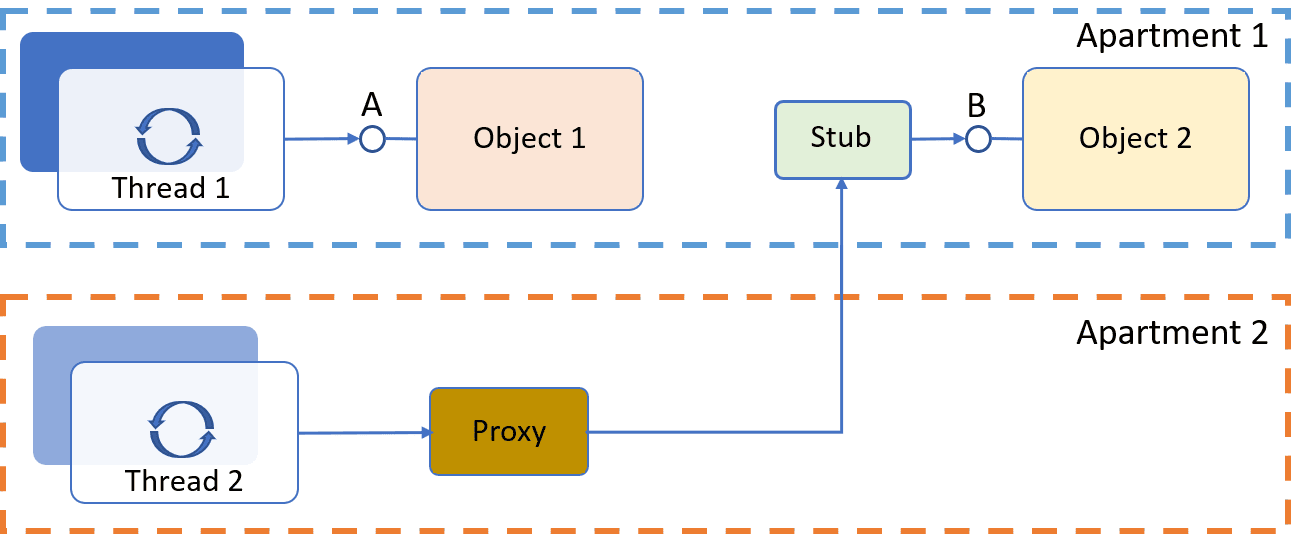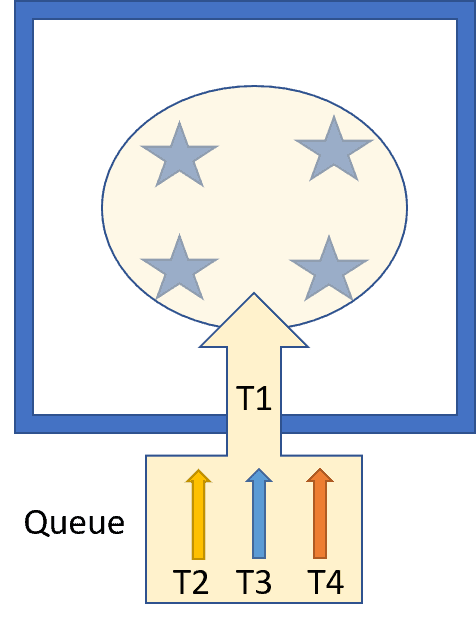1. 概述
在 COM(Component Object Model)的并发模型中,对象的执行被限制在特定的“套间”(Apartment)中。我们通过两种主要方式访问这些对象:STA(Single-Threaded Apartment)单线程套间 和 MTA(Multi-Threaded Apartment)多线程套间。
本文将介绍 COM 套间的概念,并深入对比 STA 和 MTA 的工作机制,以及它们各自的优缺点和适用场景。
2. COM 套间模型
COM 是一种面向对象的组件模型,用于构建可分布、平台无关、彼此通信的软件组件。
当创建或操作一个 COM 对象时,COM 会为该对象分配一个“套间”。这个套间就像一个边界,限制了哪些线程可以安全地访问该对象。任何想与该对象交互的线程,都必须与它所在的套间建立某种关联。
套间的主要目的是帮助 COM 实现对非线程安全对象的调用串行化。
示例图:

在图中:
- 线程 1 直接访问对象 1 的接口 A,因为它们在同一个套间内。
- 接口是线程与对象之间沟通的桥梁,它负责将参数转换为对象能理解的形式。
2.1. 代理/存根对(Proxy/Stub Pair)
对于不在同一套间的线程(如线程 2),它访问对象 2 的接口 B 时必须通过 代理(Proxy)和存根(Stub) 对。
- ✅ Proxy:运行在客户端套间中,负责将调用打包。
- ✅ Stub:运行在服务端套间中,负责解包调用并执行目标方法。
COM 使用“封送”(Marshaling)机制将接口指针从一个套间传输到另一个套间,因为 COM 无法预先知道对象具体实现了哪些接口。
⚠️ 对象无法跨套间直接通信,必须通过封送机制。我们可以使用 COM 默认的封送机制,也可以自定义代理和封送逻辑。
COM 默认的 Stub 生成机制依赖于 接口定义语言(IDL),用于描述客户端和服务器之间的接口。IDL 会标记每个参数是输入、输出还是双向参数:
- 输入参数会被复制到服务端。
- 输出参数会被复制回客户端。
3. 单线程套间(STA)
在 STA 模型中,只有创建该套间的线程才能直接访问套间内的对象。其他线程不能直接访问,必须通过代理。
COM 会自动处理线程之间的同步工作。
示例图:

图中:
- 星号代表套间内的对象(蓝色矩形)。
- T1–T4 表示尝试访问对象的线程。
- 只有 T1 能访问对象,其他线程(T2–T4)必须排队等待。
3.1. 优缺点分析
✅ 优点:
- 适合对象无法自行处理并发的情况。
- 套间可容纳任意数量的对象。
- COM 自动处理同步逻辑,开发者无需关心。
❌ 缺点:
- 同一时间只能处理一个调用,性能受限。
- 所有线程访问都必须通过代理,效率较低。
4. 多线程套间(MTA)
在 MTA 模型中,对象本身负责同步逻辑,COM 不会自动为其做同步。
MTA 套间可以同时容纳多个线程和多个对象,它们之间可以直接通信而无需代理。
但这也意味着多个线程可能同时访问并修改对象数据,开发者必须自行实现同步机制以保证数据一致性。
示例图:

图中:
- T1–T3 是尝试访问对象的线程。
- 在 MTA 模型中,线程可以直接访问对象,无需排队。
⚠️ 一个应用程序中只能有一个 MTA 套间,但可以有多个 STA 套间。
4.1. 优缺点分析
✅ 优点:
- 多个线程可并行执行,提升性能。
- 线程间直接通信,减少代理开销。
❌ 缺点:
- 实现复杂,需要对象本身具备线程安全性。
- 即使只对部分对象进行同步,整体性能也可能下降。
5. STA 与 MTA 的对比总结
| 特性 | STA | MTA |
|---|---|---|
| 同一时间执行线程数 | 1 个 | 多个 |
| 是否需要代理 | 是 | 否 |
| 适用场景 | 对象无法处理并发 | 对象可处理并发 |
| 性能 | 较快(单线程) | 较慢(需同步) |
| 同步粒度 | 整个套间 | 单个对象 |
6. 总结
本文介绍了 COM 中的两种线程模型:STA 和 MTA。
- ✅ 当 COM 对象不具备线程安全性时,使用 STA 是更稳妥的选择。
- ✅ 当 COM 对象具备线程安全能力时,使用 MTA 可以提升并发性能。
⚠️ 选择合适的模型,不仅影响程序的性能,还直接关系到系统的稳定性与可维护性。合理使用 STA 和 MTA,是开发 COM 组件时的关键考量之一。